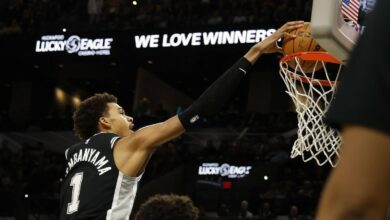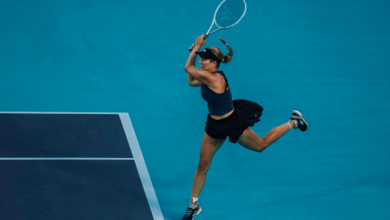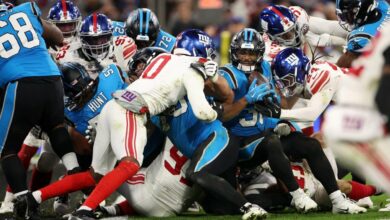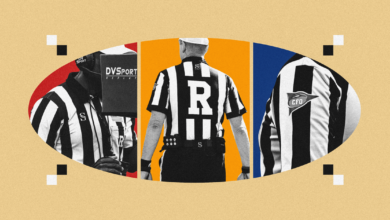How do Premier League teams kick off games in 2024-25?
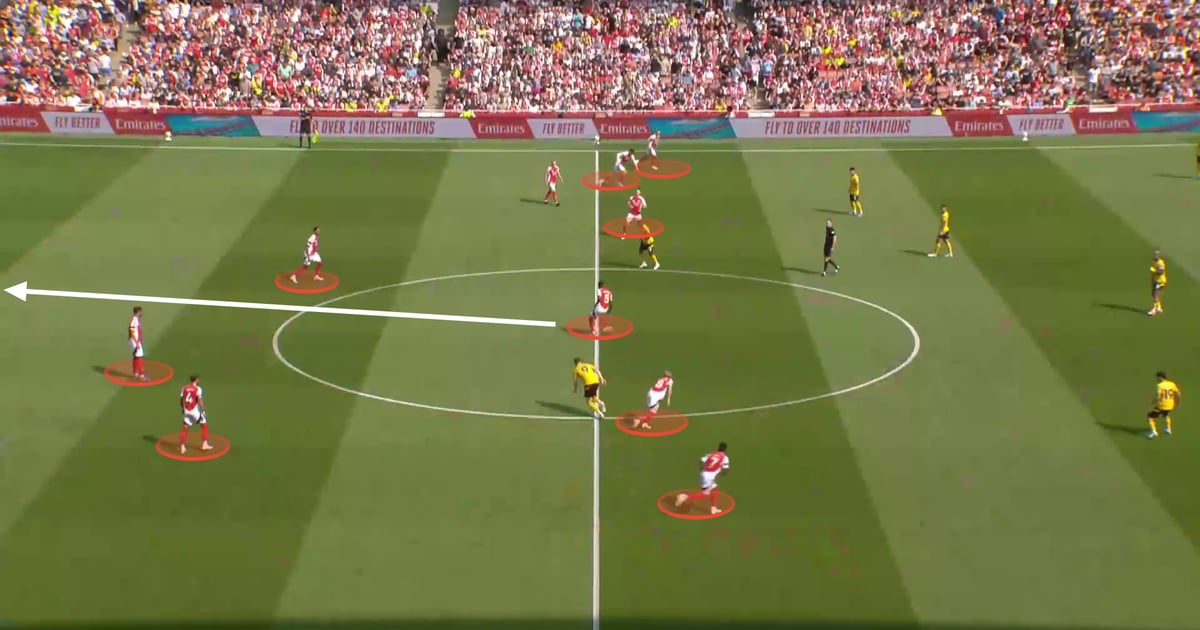
Plenty of attention has been paid to the new ‘Dynamic Kick-off’ regulations in American football’s NFL in the early days of its 2024 season but even in the fluid realm of the Premier League, how a team begins play is an increasingly-rehearsed process.
And despite the ongoing evolution in intricate tactics, even the greatest of Johan Cruyff’s disciples seem keen to return the game to its roots by hoofing the ball up the pitch from kick-off. Each of last season’s final top six in the Premier League have done so at some point in their first three matches of 2024-25. However, they have also provided variety in the ways they line their players up, and how quickly they get the ball forward.
Below, The Athletic analyses the kick-off routines used by Manchester City, Arsenal, Liverpool, Aston Villa, Tottenham Hotspur and Chelsea (to start either a game or the second half of one) across the first three weeks of the season ahead of the Premier League’s return this weekend.
Manchester City
As you would expect from a Pep Guardiola team, City’s kick-off routines have been attempts to retain control through short passes and plenty of off-ball movement.

Ahead of their first kick-off of the season away at Chelsea, Kevin De Bruyne and Bernardo Silva both lined up close to the ball, with Savinho out wide on the left and Erling Haaland and Jeremy Doku close to each other on the right. Rico Lewis was the sole defensive member of the team to the left with their other defenders forming the final line behind Mateo Kovacic on the edge of the centre circle.
De Bruyne passed the ball back to goalkeeper Ederson, who went long towards Haaland on the right. He flicked it on, but Chelsea ’keeper Robert Sanchez came off his line to collect the ball close to the edge of the box before Doku could reach it. By the time Sanchez caught the ball, City had seven players close to his penalty box to kickstart the press.

At home against Ipswich Town the following weekend, Guardiola opted for a different approach when City kicked off the second half (they were leading 3-1 by then). De Bruyne and Bernardo still stayed close to the ball, but Haaland joined Savinho out wide on the right while Doku was positioned further inside on the other flank. Lewis, on the right, lined up alongside Kovacic, who stood near the edge of the circle again, while the back three were positioned deeper than they had been at Stamford Bridge.
City began the second half with a 14-pass move in which they found both Savinho and Doku at different points, with seven players in total getting a touch. When Ipswich finally cleared the ball for a throw-in, City had De Bruyne and Bernardo in pockets where they could cause damage and both wingers high and wide with limited immediate pressure.

At West Ham, City chose a similar approach to the Ipswich one before the opening kick-off but with Jack Grealish alone on the left while Haaland and Doku went wide on the right. Their back three were much closer together that time and leaned more towards the left, indicating they would channel their first attack of the match to the right.
De Bruyne again passed all the way back to Ederson, who shaped up for a long pass but then went short to left-back Josko Gvardiol, who returned it to him. City then drew West Ham towards the left with De Bruyne dropping deep, as he did against Ipswich, before playing it out to their right and finding Lewis in acres of space. When Lewis received the ball, he was ahead of six West Ham and five City outfield players, giving the champions a chance to cause some early damage.

Arsenal

Arsenal have had a set pattern in place across their three league games so far, passing the ball back to goalkeeper David Raya from kick-off and surging towards the flanks in numbers while leaving central areas open. Raya is then tasked with hitting one of the wings; he went towards the left against Wolves and Brighton, and to the right against Aston Villa.
In the Wolves game, Arsenal had a front five streaming forward even before Thomas Partey knocked the ball back towards Raya. Bukayo Saka and Martin Odegaard made inward runs on the right anticipating a long ball to the left, where Declan Rice is most central with Gabriel Martinelli holding the width and Kai Havertz between them, while Oleksandr Zinchenko stayed back. Arsenal’s defenders stayed in a high final line to ensure they could move further up once Raya, who came well outside his box, launched the ball forward.
By the time Raya readied himself to kick, William Saliba was the lone defender in the final line with Gabriel and Ben White, who also made their way forward.
Wolves stepped forward to try to win the ball just beyond the halfway line, but it came back to Zinchenko. He played it forward to Martinelli, but the Brazilian’s subsequent pass towards the middle was cleared.

Wolves recovered possession quickly but as Arsenal already had men forward, they pressed them to force a long pass and won the ball back by the 34-second mark.
Away to Villa, Arsenal used a different tactic by opting to go to the right flank instead. Havertz moved over to the right to charge forward with Saka, while Odegaard stayed more central. Rice and Martinelli made more conservative runs on the left while the back four stayed high in line with the edge of the centre circle.
When Partey’s pass got to Raya, Saliba was the furthest behind once again while all the runners moved towards the right. Raya’s long ball was nodded on by Havertz, who occupied the same area as Saka, allowing Villa left-back Lucas Digne to get a head start and marshal the ball out for a goal kick. The move mirrors City’s approach against Chelsea the previous weekend.
Finally, against Brighton, Arsenal went to the left again, with Havertz once more drifting over to the other side. This time, they kept two centre-backs in front of Raya, anticipating a higher Brighton press, with Saliba even blocking opposition striker Danny Welbeck. Raya’s pass was met by Jan Paul van Hecke, who headed it out for a throw-in.
By then, nine Arsenal players were in the Brighton half, allowing the home side to establish early territorial dominance.

Winning the initial header doesn’t seem to be Arsenal’s focus from these routines, particularly considering the 5ft 8in (178cm) Leandro Trossard was their left-winger against Brighton, though Havertz’s 6ft 4in height does help, as it did against Villa. The aim is for them to get as many of their players forward as possible, pinning the opposition back rather than prioritising control.
Liverpool

Liverpool huddle before kick-off at Manchester United on September 1 (Paul Ellis/AFP via Getty Images)
Arne Slot’s early months as Liverpool head coach have seen him receive praise for establishing an identity that blends the best qualities of Jurgen Klopp’s 2023-24 squad with his own touches.
Liverpool have continued to use a high line and that has been evident from their kick-off setups, which is similar to Arsenal’s.
On the opening weekend against Ipswich, Dominik Szoboszlai was tasked with kicking off the contest, with four team-mates also close to the halfway line.

Unlike City and Arsenal, who have players starting from wide positions, Liverpool were much narrower. Luis Diaz, Diogo Jota and Alexis Mac Allister lined up on the left while Mohamed Salah took up the sole spot on the right. Behind them, Trent Alexander-Arnold inverted to form a midfield line with Ryan Gravenberch, with Liverpool’s remaining defenders forming the final line just beyond the centre circle. Both the first and final lines compressed space by lining up next to each other.
Below, Szoboszlai passed to goalkeeper Alisson, who went long towards the left. Like Haaland and Havertz from the examples above, the ball was directed towards Jota, who was in the half-space rather than wide, which helped him find Diaz further out. The Colombian received support from Andy Robertson and the latter’s first-time cross was cleared.

Slot went one step further in his official Anfield bow against Brentford the following week. To kick off the game’s second half, the front four remained the same but the midfield two became a trio with Robertson inverting to position himself directly behind Jota on the left. Ibrahima Konate and Virgil van Dijk formed the final line right next to the centre circle.
This time around, Alisson’s long pass was met by Brentford defender Nathan Collins, who was then fouled when he went up for a return header after the ball was sent forward again by Robertson. When the foul occurred, every Liverpool outfield player was in Brentford’s half. With the play drawn towards the left, Szoboszlai, Alexander-Arnold and Salah were in space on the right.
Then, against Manchester United, deemed the first big test of Slot’s tenure, the Dutchman unleashed what looked like an even more daring approach to start the second half, despite holding a 2-0 lead at Old Trafford. The front line of four was backed up by a second line of four with Gravenberch, Van Dijk and Robertson on the left and Alexander-Arnold in the half-space on the right. Konate was furthest back but still higher than he had been against Ipswich or Brentford.
However, as Alisson readied himself to launch one upfield, Van Dijk and Robertson dropped back even as their other team-mates made their way forward. Alisson’s pass was met by Jota, who (after a couple of ricochets) got past United right-back Noussair Mazraoui to the byline. Liverpool were unable to get enough men into the box, though, and Jota’s final pass sailed out for a throw-in on the other side of the pitch. They did, however, have enough players in United’s defensive third to disrupt their restart from the ensuing throw-in.

Liverpool’s approach from kick-offs, while mirroring Arsenal’s on the surface, has the positional interchanges we see from City.
Jota and Diaz are both capable of switching between the left-winger and centre-forward positions and this approach also allows Salah to begin halves with lower intensity and conserve his energy.
Aston Villa

Villa are the first team on this list to start matches off with a forward and use a midfield recipient from kick-off, with an emphasis on control and baiting the opposition’s press.
Away against West Ham on the opening weekend, Morgan Rogers started the second half for Villa with Ollie Watkins and Leon Bailey lining up close to each other on the left and John McGinn tucking inside on the right. Youri Tielemans and Amadou Onana stood right next to each other within the centre circle, while Villa’s back four formed their final line a few yards further back, fanning out to cover the middle of the pitch and both flanks.
Below, Rogers passed the ball to Tielemans, who went back to Pau Torres. As West Ham committed men forward, Villa played it out wide to right-back Matty Cash, who beat his man but then gave the ball away, before Villa won a throw-in in their own half.

Unai Emery’s side were much more conservative when they took on Arsenal at home the following weekend.
This time, Watkins moved to the right, leaving Bailey as the sole runner on the left. Tielemans pushed closer to Rogers while Onana retained his position near the edge of the centre circle. The gap between Onana and the back four was much larger, while the full-backs pushed slightly further ahead of their centre-backs.
Villa passed back to goalkeeper Emiliano Martinez, who, with the team’s overall shape, would have been expected to go towards the left wing. However, Havertz cleverly presses him on that side to force Martinez to pass to the right wing, where Jurrien Timber wins the initial duel but then gives the ball away. From there, Villa worked it back to their defenders before eventually surrendering possession as Arsenal pressure resulted in Torres passing to an offside Bailey.
Against Leicester City in their third match of the season, Emery unleashed another pre-kick-off formation.
This time, Watkins returned to the left alongside McGinn, while Onana moved further up the pitch to join Bailey on the right, so forming a front four. Tielemans stood just a couple of feet away from Rogers to receive the initial ball, while Digne inverted to line up a few yards behind McGinn and Watkins, leaving plenty of space in midfield.
Rogers passed to Tielemans as expected, and he played the ball further back to the defence. Torres tried to dribble out of danger but couldn’t and Leicester cleared it back to their defence before constructing a move that pegged Villa back, indicating the risk this approach holds when Emery’s side fail to wriggle out of pressure.


Tottenham Hotspur

Tottenham’s kick-off setup contrasts with all the teams above in terms of width.
In the example below from their opening fixture against Leicester, Spurs, like Villa, kicked off using a forward in Dominic Solanke, but stationed Son Heung-min and Brennan Johnson extremely wide on the left and right respectively, with James Maddison starting close to Solanke.
Their second line leaned towards the left; Rodrigo Bentancur was on the edge of the centre circle in midfield with Pedro Porro in the right half-space and Pape Sarr in between them. Destiny Udogie was slightly behind in the left half-space, leaving just centre-backs Cristian Romero and Micky van de Ven to form the final line closer to their penalty area than to their team-mates. Romero and Van de Ven then fanned out, hinting that Spurs would start with short passes, which was what they did.
Solanke passed the ball to Bentancur, who played a one-two with Sarr before finding Van de Ven. Spurs worked the ball to Maddison, dropping deep on the left flank (similar to De Bruyne for City), and he tried to find Udogie, whose poke forward was too far ahead for Solanke to reach.

With Solanke out injured against Everton, Spurs brought Wilson Odobert into their line-up, while Dejan Kulusevski also started.
As Son, as the centre-forward, prepared for kick-off, he had two options close to him in Maddison and Kulusevski, while Johnson and Odobert held the width once again. The second line was formed by Porro drifting into central midfield, the returning Yves Bissouma at the edge of the centre circle and Udogie much wider on the left. Romero and Van de Ven formed the final line but were higher up the pitch than against Leicester, a signal they anticipated less pressure from the outset than in Leicester.
Son found Bissouma with the first pass and the midfielder went long, towards Odobert on the left. Odobert won the second ball and fed Maddison, but Spurs ended up going back to their defence, still staying within Everton’s half as the visitors sat deep.
In the most recent match, against Newcastle, Spurs used yet another kick-off shape as they began the second half 1-0 down.
As Son prepared to make the opening pass, Johnson again positioned himself wide on the right, but Udogie was now the widest player on the other flank with Odobert dropping inside, while Kulusevski was deeper than where he was positioned in the Everton match. Porro also pushed up to man the right side of the second line, with Maddison in a deeper position down the middle and Bissouma on the left. The gap between midfield and their two-man defensive line was smaller as Spurs aimed to push forward from the start of the half in search of an equaliser.
On this occasion, Son played it to Kulusevski, who lofted a ball towards Udogie on the left — as Bissouma did for Odobert against Everton. The pass was too heavy and Newcastle won it back, but as Spurs pushed men forward, they regained possession quickly. The resulting sequence saw Kulusevski’s shot from inside the box deflected.
Spurs’ system under coach Ange Postecoglou has often depended on high-risk, high-energy football and their kick-offs are a good illustration of that. Their setup allows them to stream men forward and, more importantly, compress the wide areas to force teams down the middle, where they can win the ball back by applying pressure.
Chelsea

Chelsea’s kick-off approach under new head coach Enzo Maresca is quite different from their approach with Mauricio Pochettino in the dugout last season.
Instead of Conor Gallagher, sold to Atletico Madrid in the summer, or another midfielder, Nicolas Jackson has been handed kick-off duties by Maresca. Chelsea have used a mix of Spurs’ and City’s approaches, stationing their left-winger out wide while allowing Cole Palmer on the right to stay closer to Jackson.
Against City on the opening weekend, Enzo Fernandez gave Jackson a short initial option on the left, with Moises Caicedo and Romeo Lavia on the edge of the centre circle. Chelsea’s back four stayed closer to their box with Malo Gusto and Marc Cucurella inverting from the right and left, respectively.
To start the second half, trailing 1-0, Jackson passed to Cucurella, who tried to go long towards Christopher Nkunku wide on the left, but the pass was too heavy, and City saw it through to Ederson with minimal pressure. Given the quality of the opposition, Chelsea didn’t press too high, granting City’s back three the space and time to get into a passing rhythm.

Chelsea’s approach seemed to be a reaction to playing a superior side in the four-in-a-row champions, however, as they changed their setup away against Wolves the following weekend.
The inclusion of Noni Madueke and Lavia’s absence through injury meant, in addition to having Palmer close to Jackson, Maresca could station both wingers — Mykhailo Mudryk on the left and Madueke on the right — out wide. Gusto joined the midfield to form a trio with Fernandez and Caicedo, which meant the right-back area was completely empty, with Cucurella inverting and pushing ahead and the centre-backs staying close to each other in the middle.
This time, Jackson passed to right centre-back Wesley Fofana, who immediately went long towards Madueke. The winger was open and flicked the ball on towards Palmer, but Wolves skipper Mario Lemina got there first. As Wolves then tried to move forward, Chelsea pressed high to force the opposition to the left, trying to tempt them into a risky switch which never came.
The setup Maresca used against Crystal Palace in the third match might be the one he sticks with as the Chelsea squad get accustomed to his tactics.
Chelsea, winning 1-0, kicked off the second half with Fernandez, who had Jackson (left) and Palmer (right) closest to him while Pedro Neto hugged the touchline on the left and Madueke was stationed wide right. Gusto and Caicedo formed a much deeper second line, with Cucurella wider than in previous matches. The centre-backs were also deeper than before, staying closer to their penalty area.
Fernandez passed the ball back to Sanchez, who, under no pressure, lofted the ball towards the left. Chelsea failed to win the first header and Fernandez’s second header towards Neto was cleared out. When the ball went out of play, Chelsea had Palmer, their primary creative outlet, in the kind of position they would want him, but their rest defence was slightly vulnerable with Caicedo moving up the pitch.

Space and time may have limited us to a deep dive on only last season’s top six in this article but fans of Bournemouth, Brighton, Newcastle and Manchester United can analyse their team’s kick-off approach in the graphics below:





